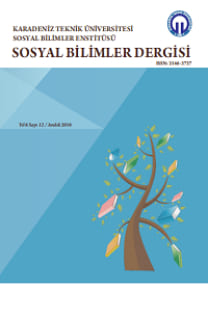TÜRKİYE’DE KAMU HARCAMALARI ENFLASYON İLİŞKİSİNİN AMPİRİK ANALİZİ: 1990-2015 DÖNEMİ
Toplumda, bir arada yaşama arzusunda olan insanların birtakım ihtiyaçları ortaya çıkmış ve toplumun zamanla gelişmesi bu ihtiyaçları önemli boyutlara ulaştırmıştır. İhtiyaçların yerine getirilebilmesi de önemli miktarda harcama yapılmasını zorunlu kılmıştır. Bu ihtiyaçlar doğrultusunda devletin yapmış olduğu harcamalar da giderek artmıştır. Bu çalışmanın amacı, Türkiye ekonomisindeki kamu harcamaları ile enflasyon arasındaki ilişkinin analiz edilmesidir. Söz konusu ilişkinin belirlenmesinde 1990-2015 dönemine ait yıllık veriler, zaman serisi analizi yöntemine tabi tutulmuştur. Çalışmada yer alan modellerde; tek değişkenli ve çok değişkenli zaman serisi analizleri kullanılmıştır. Tek değişkenli analizlerde; toplam kamu harcamaları, cari harcamalar, yatırım harcamaları ve transfer harcamalarının enflasyon oranı üzerinde pozitif yönlü ve istatistiksel olarak anlamlı bir sonuç verdiği bulgusuna ulaşılmıştır. Çok değişkenli analizde ise; cari harcama değişkeninin enflasyon oranı üzerindeki etkisinin de tek değişkenli analizde olduğu gibi pozitif yönlü ve istatistiksel olarak anlamlı olduğu sonucuna ulaşılmıştır. Buna karşılık yatırım harcamaları ve transfer harcamaları değişkenleri için istatistiksel olarak güçlü kanıtlar sağlanamamıştır
EMPIRICAL ANALYSIS OF THE RELATIONSHIP BETWEEN PUBLIC EXPENDITURES AND INFLATION IN TURKEY: THE PERIOD 1990-2015
As a result of living together in society, human being requires a number of needs and they enhanced these needs with the development of society to a great extent. There should be a significant amount of expenditure to fulfil these needs. The expenditures which are made by the government have been increasing over time. The aim of this study is to analyse the relationship between state expenditure and inflation. To determine this relationship, the annual data between 1990-2015 is used. This article includes two different model; univariate-regression analysis and multi-variate regression analysis. The empirical results of univariate regression analysis indicate that inflation rates are positively and significantly correlated with total public expenditure, current expenditures, investment expenditures and transfer expenditures. Similarly, the empirical results of multivariate regression analysis demonstrate that the impacts of current expenditure on inflection rate are positively and statistically significant. On the other hand, there was no statistically strong evidence for investment expenditures and transfer expenditure variables
___
Agbewali, F. (2011). Critical Analysis of the Impact of Government Expenditure and Money Supply on Inflation Rate on the Economy of Ghana, Regent-Maastricht School of Management, 1-54.Ayo, O. S., Ifeakachukwu, N. P., & Ditimi, A. (2012). A Trivariate Causality Test among Economic Growth, Government Expenditure and Inflation Rate: Evidence from Nigeria, Research Journal of Finance and Accounting, 3(1), 65-72.
Bozkurt, H. Y. (2007). Zaman Serileri Analizi, Birinci Basım, Ankara: Ekin Kitabevi.
Bütçe ve Mali Kontrol Genel Müdürlüğü (BÜMKO), (2016), http://www.bumko.gov.tr/TR,147/ ekonomik-gostergeler.html (08.11.2016).
Bütçe ve Mali Kontrol Genel Müdürlüğü (BÜMKO), (2016), http://www.bumko.gov.tr/ Eklenti/9922,denge2016.pdf?0 (08.11.2016).
Bütçe ve Mali Kontrol Genel Müdürlüğü (BÜMKO), (2016), http://www.bumko.gov.tr/TR,160/ konsolide-butce-buyuklukleri-program-butce-siniflandirm-.html (08.11.2016).
Bütçe ve Mali Kontrol Genel Müdürlüğü (BÜMKO), (2016), http://www.bumko.gov.tr/TR,164/ merkezi-yonetim-butce-dengesi-donusum-tablosu--2000-201-.html (08.11.2016).
Ezirim, C., Muoghalu, M., & Elike, U. (2008). Inflation versus Public Expenditure Growth in the US: An Empirical Investigation, North American Journal of Finance and Banking Research, 2(2), 26-40.
Georgantopoulos, A. & Tsamis, A. (2012). The Inter relationship Between Money Supply, Prices and Government Expenditures and Economic Growth: A Causality Analysis for the Case of Cyprus, International Journal of Economic Sciences and Applied Research, 5(3), 115-128.
Gökalp, M. F. & Avcı, M. (2002). Türkiye Ekonomisi’nde Mali Disiplinsizlik Olgusu, Muğla Üniversitesi Sosyal Bilimler Enstitüsü Dergisi, (7), 1-15.
Han, S. & Mulligan, C. (2008). Inflation and the Size of Government, Federal Reserve Bank of St. Louis Review, 90(3), 245-267.
Magazzino, C. (2011). “The Nexus Between Public Expenditure and Inflation in the Mediterranean Countries, Munich Personal Repec Archive (MPRA), Paper No: 28493, 1-19.
Okafor, C. & Eiya, O. (2011). Determinants of Growth In Government Expenditure: An Empirical Analysis of Nigeria, Research Journal of Business Management, 5(1), 44-50.
Ruge M.F. (1999). Government Expenditure and the Dynamics of High Inflation, Journal of Development Economics, (58), 333-358.
Şahin, M. & Özenç, Ç. (2007). Kamu Harcamaları ile Makro Ekonomik Değişkenler Arasındaki Nedensellik İlişkileri, Yönetim Bilimleri Dergisi, 5(2), 199-225
- ISSN: 2146-3727
- Yayın Aralığı: Yılda 2 Sayı
- Başlangıç: 2011
- Yayıncı: Karadeniz Teknik Üniversitesi Sosyal Bilimler Enstitüsü
Sayıdaki Diğer Makaleler
TÜRKİYE’DE KAMU HARCAMALARI ENFLASYON İLİŞKİSİNİN AMPİRİK ANALİZİ: 1990-2015 DÖNEMİ
ALAIN TOURAINE'İN DEMOKRASİ DÜŞÜNCESİ ÜZERİNE BİR DEĞERLENDİRME
TÜRKİYE'DE ENFLASYON HEDEFLEMESİNİN MAKROEKONOMİK PERFORMANS ÜZERİNDEKİ ETKİLERİ
BAHAR BURTAN DOĞAN, ZEKİ AKBAKAY
TÜRKİYE'DEKİ MUHASEBE ANLAYIŞININ GELİŞİM SÜRECİ VE MEVCUT DURUMUN İNCELENMESİ
OSMANLI DEVLETİ'NDE İHRACAT VE İTHALAT ARASINDAKİ UZUN DÖNEM İLİŞKİSİ: 1840-1913
RAHMİ YAMAK, NEBİYE YAMAK, Sinem KOÇAK
TÜRKİYE'DE GELİR DAĞILIMININ SOSYO EKONOMİK PROFİLİ
